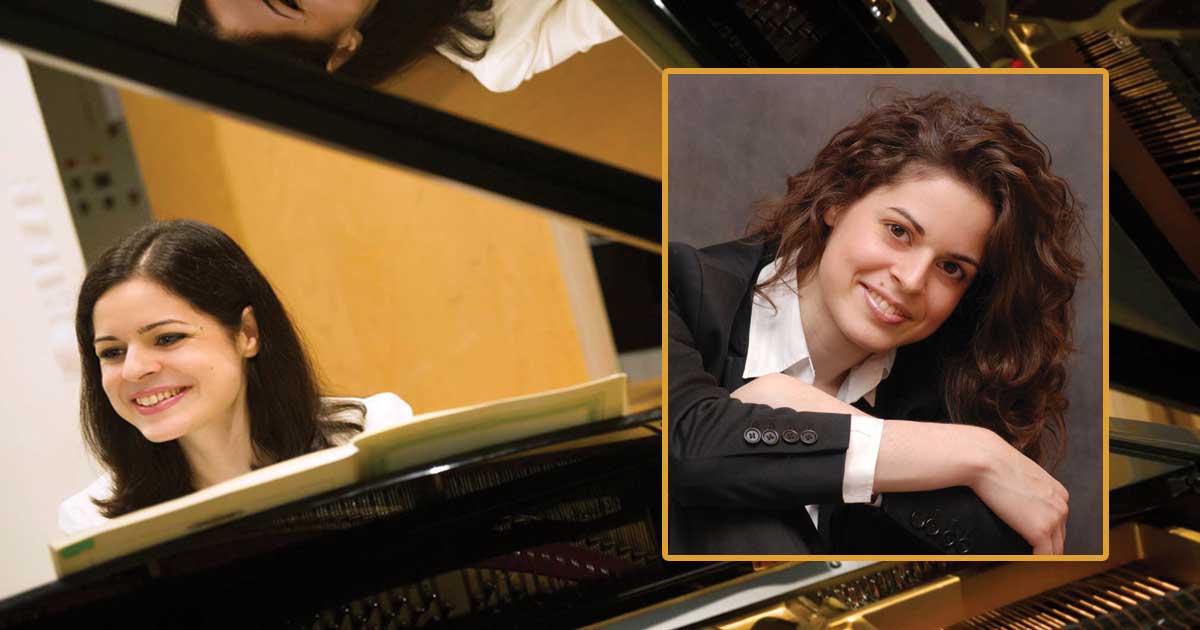
About
Star power in every note. Gramophone says Zlata Chochieva brings “an inner glow to every bar,” and Miami Herald remarked she is “a natural Rachmaninoff player, coaxing a darker sound from the keyboard and reveling in the big romantic melodies.” Gramophone includes her recording of the Etudes in their Top Ten Chopin CDs. She is among the breakout performers as a Gilmore Rising Star for the 2018-19 Season.
She was born in Moscow and is now a resident of Salzburg. She made her first stage appearance at age five, and made her debut two years later performing Mozart’s Concerto No. 17 at the Grand Hall of Moscow State Conservatory. Chochieva caught the attention of Mikhail Pletnev, who invited her to play concerts with Russian National Orchestra and study with him as one of only two students at that time.
Chochieva is lauded as an impeccable talent who is a great Romantic pianist. Her program highlights her artistry and imagery. A perfect way to open a splendid 24th Season.
Program
- Prelude
- Gavotte
- Gigue
- Chopin, A minor, Op. posth., B. 140 (À Émile Gaillard) (Allegretto)
- Scriabin, F-sharp minor, Op. 3, No. 2 (Allegretto non tanto)
- Chopin, C major, Op. posth., B. 82 (no tempo designation)
- Scriabin, F minor, Op. 25, No. 1 (Allegro)
- Chopin, C minor, Op. 30, No. 1 (Allegretto non tanto)
- Scriabin, F-sharp minor, Op. 25, No. 7 (Moderato)
- Allegro moderato
- Lento
- Allegro molto
Program Notes
Chopin and Scriabin loom large in the history of the mazurka as a musical form. While Chopin largely preserved the rhythms of this rustic dance from his Polish homeland, Scriabin transformed the genre into something akin to the keyboard suites of the High Baroque—instrumental miniature narratives far removed from their origins on the dance floor.
- Chopin’s Mazurka in A minor (1840) features smoothly flowing melodic lines that arch across the keyboard, creating a dialogue between the left and right hands.
- Scriabin’s first set of Mazurkas, Op. 3 (1889), composed while he was a teenager, owes much to Chopin.
- Chopin’s posthumously published Mazurka in C features the Lydian mode, common in Polish folk music. An imitation of drone pipes in the bass invokes a rustic feel.
- Surreal and dreamlike, the Mazurkas, Op. 25 (ca. 1899) inhabit a soundscape unlike the earthy yet elegant examples of Chopin.
- Chopin’s C-minor Mazurka, Op. 30 No. 1 conveys restrained pathos.
- Scriabin’s Mazurka Op. 25 No. 7 wanders lugubriously, obscuring the traditionally clear-cut mazurka rhythm.
Liszt excelled in fleet-footed, fairylike music. The second Valse oubliée (1883) combines gossamer texture interrupted periodically by choralelike interjections, featuring crunchy harmonies typical of Liszt’s late period. At times, the soundscape of Ravel’s Valses nobles et sentimentales seems not far away.
The Mephisto Waltz No. 2 (1880) features the same juxtaposition between frenetic dances and sensuous, songlike interludes that delights in the more often performed Mephisto Waltz No. 1, composed 20 years earlier. Liszt’s harmonic adventurousness in the second waltz looks forward to Scriabin and even Bartók. Liszt dedicated the work to Saint-Saëns, whose 1874 Danse macabre had made an exceptional impression on him.
In 1906, in search of a quiet place to work, Rachmaninoff moved to Dresden with his family. There, inspired by Liszt’s Faust Symphony, he began work on a sprawling piano sonata in D minor whose movements, at least initially, served as musical representations of characters in Goethe’s famous play.
The first movement is inspired by Faust himself, with its emphatic, fist-on-the-table opening theme representing his conflicted soul. In contrast, the simple, sustained melody of the secondary theme evokes Russian Orthodox chant, which so frequently inspired Rachmaninoff. The second movement is a portrait of Faust’s love, Gretchen: its radiant main theme is followed by a wandering soprano aria that arcs above a restless accompaniment. The galloping final movement depicts the demon Mephistopheles, complete with a thundering appearance of the medieval Dies Irae plainchant. As the tumultuous proceeding nears its close, a triple-forte rendition of the opening movement’s Orthodox chant rings out, with a terrifyingly effective harmonic change.